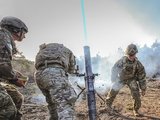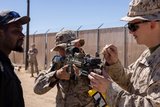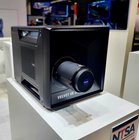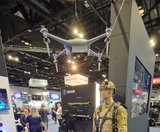Cubic tailors mortar simulator for the US Army
The company’s mortar trainer received improvements based on soldier’s feedback.
The US Navy’s USNS Lewis B Puller (T-ESB 3) Expeditionary Mobile Base has sailed from Naval Station Norfolk to undertake airborne countermine deployment training, the US Navy announced on 21 June.
The vessel carried civil service mariners (CIVMARs) and US Navy sailors, who worked with sailors attached to the ‘Blackhawks’ of Helicopter Mine Countermeasures Squadron (HM) 15 to train in mine elimination capabilities.
The four-day training battery included deploying and recovering two types of mine countermeasures from the deck of the ESB: a Magnetic Orange Pipe (MOP), a shallow-water mine countermeasure; and the Mark 105 magnetic sled, which creates a magnetic field to destroy mines as it is towed behind a helicopter.
The countermeasures were deployed in multiple phases. The ESB's deck department CIVMARs and sailors first launched three rigid-hull inflatable boats (RHIBs) that were manned by HM-15 sailors. The boats guided and manoeuvred the MOP and magnetic sled. The countermeasure devices were moved to position for towing, with the sled attached to an MH-53E Sea Dragon helicopter of the HM-15 and towed through the simulated mine target area.
Before the training, the crew was tested and qualified to handle small craft and boats, and the flight deck crew was qualified to launch and recover various aircraft. The mine countermeasures and RHIBs were successfully brought back to the ESB after the simulated mine target area was cleared.
Apart from countermine training evolutions, Puller's crew practiced flight deck firefighting techniques; performed vertical replenishment training with the Afloat Training Group; and trained to counter the threat of a small boat attack.
Bryan Stoots, Puller's chief mate, said: ‘We got underway to train in preparation for a future Initial Operational Test and Evaluation. We performed a mock Airborne Mine Countermeasures (AMCM) mission, which included deployment of countermine assets from the ship's AMCM inventory.’
USNS Lewis B. Puller will be deployed to the US 5th Fleet area of responsibility in 2017 after undergoing upgrades and modifications.

The company’s mortar trainer received improvements based on soldier’s feedback.

The company will operate in two new locations in the coming years to better support US services.

This type of tool provides more realistic training easing the incorporation of new scenarios that accurately represent the threats of the battlefield.

The Engineering Corps has been conducting individual instruction using FLAIM Systems’ Sweeper and should start collective deployments in 2025.

The next-generation platform is motion-compatible and can be used in OTW and NVG applications.

The system can be used to prepare soldiers for both drone offensive operations and CUAS missions.